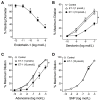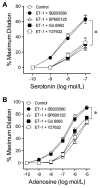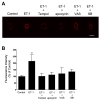Endothelin-1 impairs coronary arteriolar dilation: Role of p38 kinase-mediated superoxide production from NADPH oxidase
- PMID: 26211713
- PMCID: PMC4558216
- DOI: 10.1016/j.yjmcc.2015.07.014
Endothelin-1 impairs coronary arteriolar dilation: Role of p38 kinase-mediated superoxide production from NADPH oxidase
Abstract
Elevated levels of endothelin-1 (ET-1), a potent vasoactive peptide, are implicated as a risk factor for cardiovascular diseases by exerting vasoconstriction. The aim of this study was to address whether ET-1, at sub-vasomotor concentrations, elicits adverse effects on coronary microvascular function. Porcine coronary arterioles (50-100μm) were isolated, cannulated and pressurized without flow for in vitro study. Diameter changes were recorded using a videomicrometer. Arterioles developed basal tone (60±3μm) and dilated to the endothelium-dependent nitric oxide (NO)-mediated vasodilators serotonin (1nmol/L to 0.1μmol/L) and adenosine (1nmol/L to 10μmol/L). Treating the vessels with a clinically relevant sub-vasomotor concentration of ET-1 (10pmol/L, 60min) significantly attenuated arteriolar dilations to adenosine and serotonin but not to endothelium-independent vasodilator sodium nitroprusside. The arteriolar wall contains ETA receptors and the adverse effect of ET-1 was prevented by ETA receptor antagonist BQ123, the superoxide scavenger Tempol, the NADPH oxidase inhibitors apocynin and VAS2870, the NOX2-based NADPH oxidase inhibitor gp91 ds-tat, or the p38 kinase inhibitor SB203580. However, ETB receptor antagonist BQ788, H2O2 scavenger catalase, scrambled gp91 ds-tat, or inhibitors of xanthine oxidase (allopurinol), PKC (Gö 6983), Rho kinase (Y27632), and c-Jun N-terminal kinase (SP600125) did not protect the vessel. Immunohistochemical staining showed that ET-1 elicited Tempol-, apocynin- and SB203580-sensitive superoxide productions in the arteriolar wall. Our results indicate that exposure of coronary arterioles to a pathophysiological, sub-vasomotor concentration of ET-1 leads to vascular dysfunction by impairing endothelium-dependent NO-mediated dilation via p38 kinase-mediated production of superoxide from NADPH oxidase following ETA receptor activation.
Keywords: Arterioles; Endothelin-1; Endothelium; NADPH oxidase; Superoxide.
Copyright © 2015 Elsevier Ltd. All rights reserved.
Figures







References
-
- Bender SB, Klabunde RE. Altered role of smooth muscle endothelin receptors in coronary endothelin-1 and α1-adrenoceptor-mediated vasoconstriction in Type 2 diabetes. Am J Physiol Heart Circ Physiol. 2007;293:H2281–H2288. - PubMed
-
- Miki S, Takeda K, Kiyama M, Hatta T, Moriguchi J, Kawa T, et al. Modulation of endothelin-1 coronary vasoconstriction in spontaneously hypertensive rats by the nitric oxide system. Am J Hypertns. 2000;13:83–87. - PubMed
-
- Laughlin MH, Muller JM. Vasoconstrictor responses of coronary resistance arteries in exercise-trained pigs. J App Physiol. 1998;84:884–889. - PubMed
Publication types
MeSH terms
Substances
Grants and funding
LinkOut - more resources
Full Text Sources
Other Literature Sources
Molecular Biology Databases
Research Materials
Miscellaneous

